Flags of Andorra

The flag of Andorra is a significant national symbol representing the Principality of Andorra, a small landlocked country located between Spain and France in the Pyrenees Mountains. Here are some facts about the flag:
- Design: The flag of Andorra consists of three vertical stripes of equal width. The left and right stripes are blue, while the center stripe is yellow. In the center of the yellow stripe is the coat of arms of Andorra.
- History: The current design of the Andorran flag was officially adopted on August 27, 1866. However, similar designs with the same colors have been used for centuries.
- Colors: The blue and yellow colors of the Andorran flag have historical significance. The blue represents the tradition of loyalty to France, while the yellow represents the tradition of loyalty to Spain.
- Coat of Arms: The coat of arms in the center of the flag features several elements. It consists of a shield divided into four quarters. The top left and bottom right quarters depict the arms of the Bishop of Urgell, a historic figure representing the Spanish influence in Andorra. The top right and bottom left quarters depict the arms of the Count of Foix, representing the French influence. Above the shield, there is a mitre, representing the ecclesiastical authority of the Bishop of Urgell.
- Status as a Co-principality: Andorra is a unique country with a co-principality system. It is jointly ruled by the President of France and the Bishop of Urgell in Catalonia, Spain. The flag of Andorra represents the shared sovereignty and historical ties with both countries.
- Official Usage: The Andorran flag is widely used and displayed across the country. It is flown on government buildings, at official ceremonies, and during national holidays and events.
- Flag Day: Andorra celebrates Flag Day on July 8 each year. The day commemorates the signing of the Andorran Constitution in 1993, which established the country as a parliamentary democracy.
The flag of Andorra represents the country’s unique political structure, historical ties with France and Spain, and its identity as an independent nation. It serves as a symbol of Andorran pride, unity, and sovereignty.